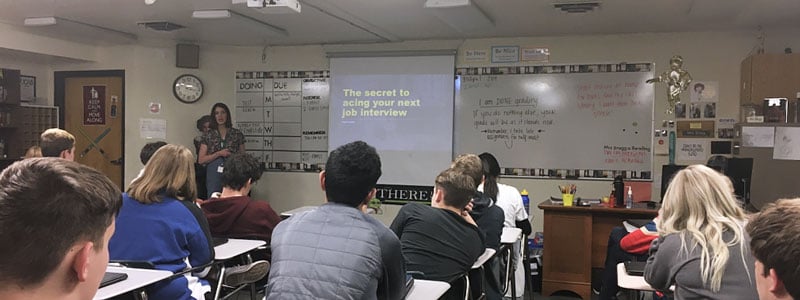Volunteer Time Off: HR Employee Teaches High Schoolers How to Ace a Job Interview
Ivanti recently implemented an unlimited Volunteer Time Off policy which enables employees to take as much time as they want to volunteer in support of a good cause. Employees from all departments have taken advantage of this policy, including technical writer Elaine Atkinson. In this post we hear how talent sourcer, Paige Dunshee, spent her volunteer time off.
Last month I utilized Ivanti’s unlimited VTO program and spent an entire work day speaking to around 150 high school sophomores at the Utah County Academy of Sciences down in Orem about job interview etiquette. As a recruiter and HR professional, I’m passionate about sharing my knowledge of interviewing dos and don’ts since I’ve seen my fair share of faux pas in my career so far.
In preparation, I created a PowerPoint presentation covering topics I felt would be the most beneficial for students who would be applying to their first jobs, such as lifeguard, babysitting, food service, etc. My goal was to help the students gain confidence in themselves and feel prepared for upcoming interviews. I remembered when I was in high school when we’d have speakers come present and they struggled to connect, and students often tuned out. I hoped I’d be able to at least keep their attention and teach them something they didn’t know so they’d remember long term.
I thought back to what I wish someone had told me when I began looking and applying for my first job. The main portion of my presentation covered the STAR Method which is a helpful guide to answering behavioral based interview questions. When I think back to my first few interviews, I remember how intimidating these types of questions were because I didn’t really understand them or why they were being asked. Now, being on the other side of the interview, I can see the point behind asking these questions to candidates and I wanted to reiterate it to the students.
The STAR Method breaks down the questions and ensures a clear and concise answer.
- Situation: Set the scene and give the necessary details of your example.
- Task: Describe what your responsibility was in that situation.
- Action: Explain exactly what steps you took to address it.
- Result: Share what outcomes your actions achieved.
As a group we reviewed several of the most common behavioral based questions such as “tell me about a time when...” and worked together to answer them using this method. After a few rounds, the students were connecting the dots and able to successfully respond with appropriate detailed answers.
Another topic I touched on was sending a thank you note or email post interview. While this is less of an option and more of a standard for me, most of the students mentioned they would have never thought to follow up and express gratitude for the interviewer’s time. I encouraged the students that even if they felt that their interview didn’t go as well as they’d hoped, that sending a follow up thank you is a great opportunity to restate their interest in the position and expand on a question that they might have stumbled on.
I was surprised that at the end of each of the five presentations when the students asked sincere and thoughtful questions. I enjoyed having this opportunity to make a positive impact on such a large group of students who were just getting started in their careers. I hope that when they’re preparing for future interviews that they’ll remember what they learned and feel good about themselves. The cherry on top of the entire day was coming home to over a hundred thank you follow up emails from the students. They must have learned something, right?

